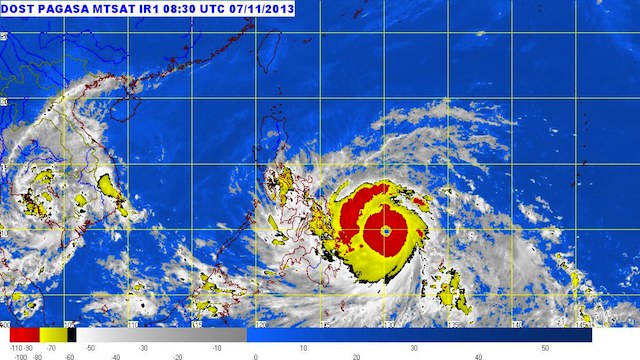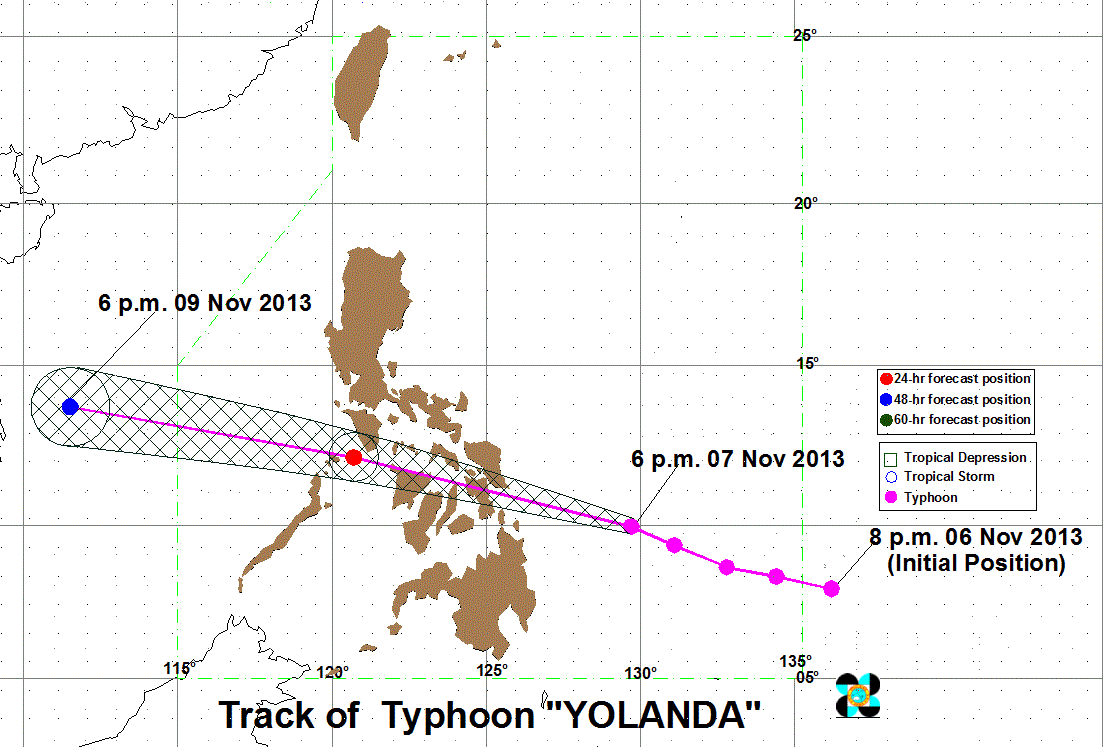SUMMARY
This is AI generated summarization, which may have errors. For context, always refer to the full article.
What’s the weather like in your area? Tweet us the situation: Use #weatheralert and tag @rapplerdotcom.

MANILA, Philippines (3rd UPDATE) – Nearly the entire Eastern Visayas has been placed under storm warning signal number 4 as super typhoon Yolanda (international codename Haiyan) intensified slightly while barreling toward the region Thursday, November 7.
Yolanda is the world’s most powerful typhoon of the year, swirling towards the Philippines and forcing mass evacuations, flight cancellations and school suspensions across the disaster-weary nation.
As of 6 pm Thursday, Yolanda was spotted 453 kilometers southeast of Guiuan, Eastern Samar, carrying maximum sustained winds of 225 km/h near the center and gusts of up to 260 km/h, state weather bureau PAGASA said in a rare 8 pm bulletin Thursday.
The typhoon’s outer rainbands are already bringing rain and winds to parts of Bicol, Eastern Visayas and Caraga, according to Weather Philippines’ latest update on the system issued 6 pm. (Weather Philippines Foundation is a Rappler partner.)
Storm signal number 4 has been raised by the state weather bureau in these provinces:
- Eastern Samar
- Samar
- Leyte
- Southern Leyte
- Biliran
- Extreme Northern Cebu including Bantayan Island
- Capiz
- Aklan
- Northern Antique
Winds of more than 185 km/h can be expected in these areas within 12 hours. This is also the first time signal number 4 has been raised in an area outside Luzon, since the typhoon signal was created in 1991.
The bureau warned of “very heavy” damage to affected communities, which will include major power and communications disruptions; severe agricultural losses; and major infrastructure damage.
PAGASA said the “situation is potentially very destructive to communities,” and advised all types of outdoor activities be cancelled.
“Evacuation to much safer shelters should have been completed earlier, since it may be too late under” a Signal Number 4 situation, the bureau warned.
Storm signal number 3, meanwhile, is in effect over the following areas:
- Siargao Island
- Dinagat Province
- Rest of Antique
- Iloilo
- Guimaras
- Northern Negros Occidental
- Northern Negros Oriental
- Northern Cebu including Cebu City
- Northern Samar
- Bohol
- Masbate
- Ticao Island
- Sorsogon
- Romblon
- Calamian Group of Islands
These areas can expect winds of 101-185 km/h within 18 hours. There will be heavy damage to agriculture; moderate to heavy disruption to power and communications; damage to structures made out of light to medium materials; and large trees could be uprooted.
Travel by any means – land, sea, or air – is dangerous.
Northern Samar is the only province in Region VIII to have a storm signal lower than 4.

Storm signal number 2, where winds between 61-100 km/h is expected within the next 24 hours, has been raised over these areas:
- Occidental Mindoro
- Oriental Mindoro
- Marinduque
- Albay
- Extreme Northern Palawan
- Burias Is.
- Rest of Negros Occidental
- Rest of Negros Oriental
- Siquijor
- Rest of Cebu
- Camiguin
- Surigao Del Norte
- Surigao Del Sur
- Agusan del Norte
There will be moderate damage to agriculture, particularly to rice and corn; partial damage to structures made of light materials; and sea and air travel will be risky.
Storm signal number 1, meanwhile, has been raised over these areas:
- Metro Manila
- Bataan
- Camarines Norte
- Camarines Sur
- Catanduanes
- Southern Quezon
- Laguna
- Rizal
- Cavite
- Batangas
- Lubang Island
- Rest of Northern Palawan including Puerto Princesa
- Misamis Oriental
- Agusan del Sur
Landfall is expected to occur in the vicinity of Guiuan, Eastern Samar or Abuyog, Leyte at around 8 am Friday, November 8, the bureau said in its 5 pm press conference.
After making landfall, the typhoon is expected to traverse Leyte, Biliran, the northern tip of Cebu, Iloilo, Capiz, Aklan, Romblon, Semirara island, the southern area of Mindoro island, and then Busuanga.
It is moving west northwest at a speed of 39 km/h, and is expected to be 55 km east of Coron, Palawan by Friday evening. It will be 1,032 km west of Manila, or outside the Philippine Area of Responsibility by Saturday evening, November 9.

Expect heavy to intense rainfall (10.0-30.0 mm/h) within the typhoon’s 600 km diameter, the bureau said.
The bureau implored people to postpone any type of travel in the areas to be affected, particularly sea travel.
Residents in areas under all storm signals should be on the lookout for possible flash floods and landslides, while storm surges up to 7 meters is possible in places under signals number 2 and 3.
The next bulletin will be released at 11 pm Thursday.
World’s strongest this year
The system had maximum sustained winds on Thursday afternoon of 278 km/h, and gusts of 333 km/h, according to the US Navy’s Joint Typhoon Warning Centre.
This made it the world’s strongest typhoon this year, according to David Michael Padua, a meteorologist with the Weather Philippines.
Areas where Yolanda will pass have been preparing for the storm, with mandatory evacuations conducted by many local governments.
President Benigno Aquino III called on his countrymen to make all possible preparations for the typhoon.
“To our local officials, your constituents are facing a serious peril. Let us do all we can while (Yolanda) has not yet hit land,” Aquino said in a nationally televised address.
“We can minimize the effects of this typhoon if we help each other. Let us remain calm, especially in buying our primary needs, and in moving to safer places.”
Quake zone in crosshairs
State weather forecaster Glaize Escullar said Yolanda is expected to hit areas still recovering from a devastating storm in 2011 and from a 7.2-magnitude quake last month.
They include the central island of Bohol, the epicenter of the earthquake that killed 222 people, where at least 5,000 survivors are still living in tents while waiting for new homes.
“The provincial governor has ordered local disaster officials to ensure that pre-emptive evacuations are done, both for those living in tents as well as those in flood-prone areas,” Bohol provincial administrator Alfonso Damalerio told Agence France-Presse.
Other vulnerable areas are the port cities of Cagayan de Oro and Iligan on the southern island of Mindanao, where flash floods induced by Tropical Storm Sendong (Washi) killed more than 1,000 people in December 2011.
Authorities said evacuations were taking place in many other towns and villages in Yolanda’s path, while schools were closed, ferry services suspended and fishermen ordered to secure their vessels.
Philippine Airlines, Cebu Pacific and other carriers announced the suspension of hundreds of flights, mostly domestic but also some international.
The Philippines is battered by an average of 20 major storms or typhoons each year, many of them deadly, but scientists have said climate change may be increasing their ferocity and frequency.
The Philippines endured the world’s strongest storm of 2012, when Typhoon Bopha left about 2,000 people dead or missing on Mindanao island in December. – With reports from Agence France-Presse/Rappler.com
Add a comment
How does this make you feel?
There are no comments yet. Add your comment to start the conversation.